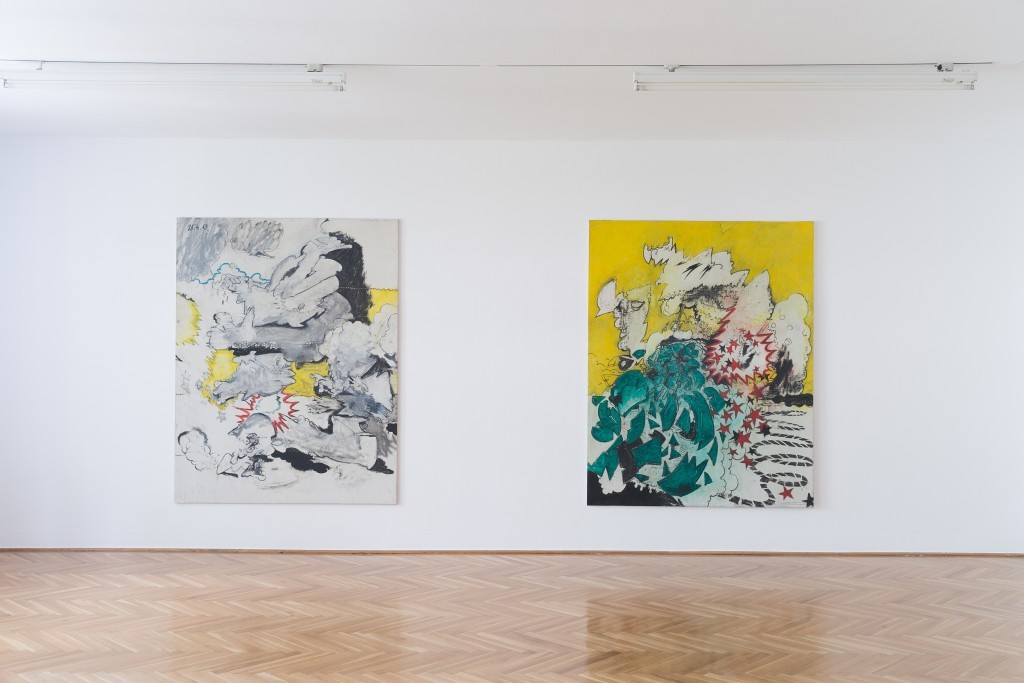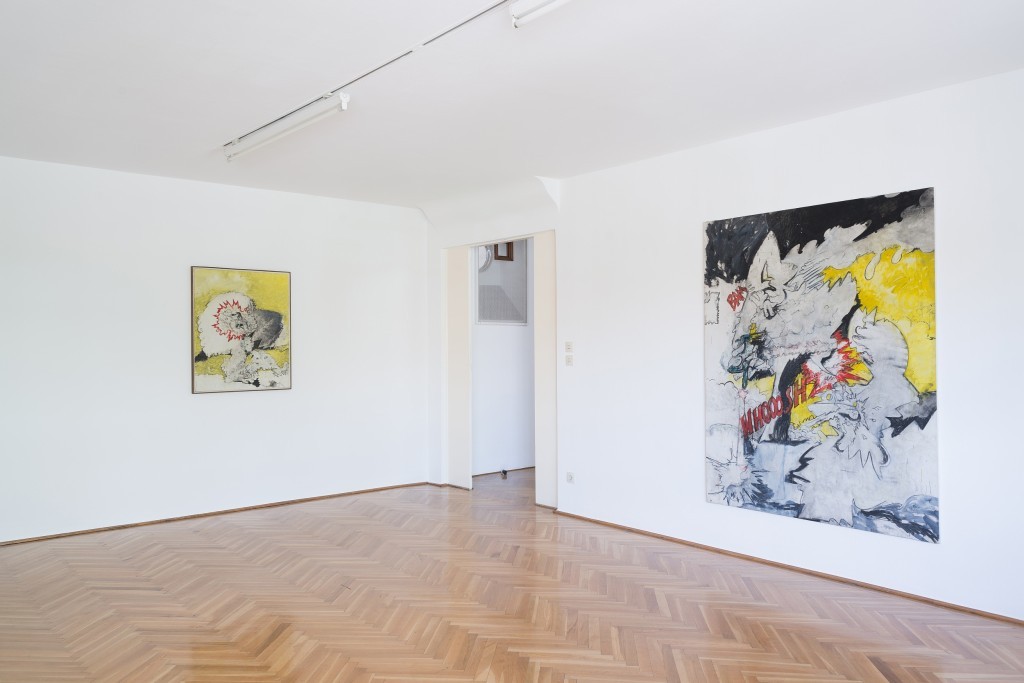Valerio Adami
01 Jul - 28 Aug 2016
VALERIO ADAMI
1 July – 28 August 2016
The illustrator and painter Valerio Adami is widely regarded as an eminent representative of Italian Pop art. His exhibition in the Secession’s Grafisches Kabinett is the artist’s first solo show in Austria and showcases a series of paintings from his less well-known early oeuvre. Created before 1964, these works stand out for the particularly dynamic interplay between expressive abstraction and stylized figuration.
Explosive discharges of energy are the dominant motif in the selected starkly simplified depictions. Adami’s pictorial spaces teem with bodies wrestling with each other and objects being blown to a thousand pieces, with energy fields, cosmic rays, fire, and dense clouds of smoke. Interspersed between them like quotations lifted from a cartoon are speech bubbles and onomatopoetic words signaling the pictures’ pop and bang. The characteristic features of Adami’s work from this time are the evolution of many of his forms out of the graphical gesture and the painterly structure he lends to different surfaces, probing the ostensible contradiction between individual emotional expression and a deadpan delivery devoid of subjective inflections with almost effortless ease.
Adami sought to chart a structurally new approach to (pictorial) space, a quest that yielded pictures balancing between painting and graphic art. Synthesizing the “critical intelligence of drawing” as the instrument that mediates access to reality with a painterly gesture, Adami’s technique frees the picture from the constraints of linear narrative and the spatial structure it entails. He achieves this effect through the mode of representation as well as the choice of what his works depict. For example, they show moments of explosive energy, but rather than revealing the cause of the explosion, they visualize its progress as though in a time lapse. Indefinable fragments hurtle through the air, stars light up, the painted space is flooded by smoke and clouds represented sometimes by graphical contours, sometimes by expanses of paint. Particular emphasis is placed on the trajectories or direction of movement of individual fragmentary objects, which are crucial to creating the impression of a staggered sequence. Not unlike the Cubists’ ingenious multiplication of space through the addition of different perspectives, Adami’s rendering of selected instants captures the multiplicity of time in intricately nested pictorial realities divorced from any perspective privileging logical causality.
Starting in 1964, Valerio Adami’s visual language developed in a fundamentally new direction. The temperamental graphical hand that thrills in his earlier works recedes in favor of a new style defined by elemental and clearly contoured shapes and areas of flatly even paint. A later set of paintings shows isolated fragments of modern life in distorted perspectives and embedded in new contexts, often with a political edge. These works have led some critics to associate Adami, who is generally labeled a Pop artist, with Narrative Figuration, a movement that first emerged in France.
1 July – 28 August 2016
The illustrator and painter Valerio Adami is widely regarded as an eminent representative of Italian Pop art. His exhibition in the Secession’s Grafisches Kabinett is the artist’s first solo show in Austria and showcases a series of paintings from his less well-known early oeuvre. Created before 1964, these works stand out for the particularly dynamic interplay between expressive abstraction and stylized figuration.
Explosive discharges of energy are the dominant motif in the selected starkly simplified depictions. Adami’s pictorial spaces teem with bodies wrestling with each other and objects being blown to a thousand pieces, with energy fields, cosmic rays, fire, and dense clouds of smoke. Interspersed between them like quotations lifted from a cartoon are speech bubbles and onomatopoetic words signaling the pictures’ pop and bang. The characteristic features of Adami’s work from this time are the evolution of many of his forms out of the graphical gesture and the painterly structure he lends to different surfaces, probing the ostensible contradiction between individual emotional expression and a deadpan delivery devoid of subjective inflections with almost effortless ease.
Adami sought to chart a structurally new approach to (pictorial) space, a quest that yielded pictures balancing between painting and graphic art. Synthesizing the “critical intelligence of drawing” as the instrument that mediates access to reality with a painterly gesture, Adami’s technique frees the picture from the constraints of linear narrative and the spatial structure it entails. He achieves this effect through the mode of representation as well as the choice of what his works depict. For example, they show moments of explosive energy, but rather than revealing the cause of the explosion, they visualize its progress as though in a time lapse. Indefinable fragments hurtle through the air, stars light up, the painted space is flooded by smoke and clouds represented sometimes by graphical contours, sometimes by expanses of paint. Particular emphasis is placed on the trajectories or direction of movement of individual fragmentary objects, which are crucial to creating the impression of a staggered sequence. Not unlike the Cubists’ ingenious multiplication of space through the addition of different perspectives, Adami’s rendering of selected instants captures the multiplicity of time in intricately nested pictorial realities divorced from any perspective privileging logical causality.
Starting in 1964, Valerio Adami’s visual language developed in a fundamentally new direction. The temperamental graphical hand that thrills in his earlier works recedes in favor of a new style defined by elemental and clearly contoured shapes and areas of flatly even paint. A later set of paintings shows isolated fragments of modern life in distorted perspectives and embedded in new contexts, often with a political edge. These works have led some critics to associate Adami, who is generally labeled a Pop artist, with Narrative Figuration, a movement that first emerged in France.


